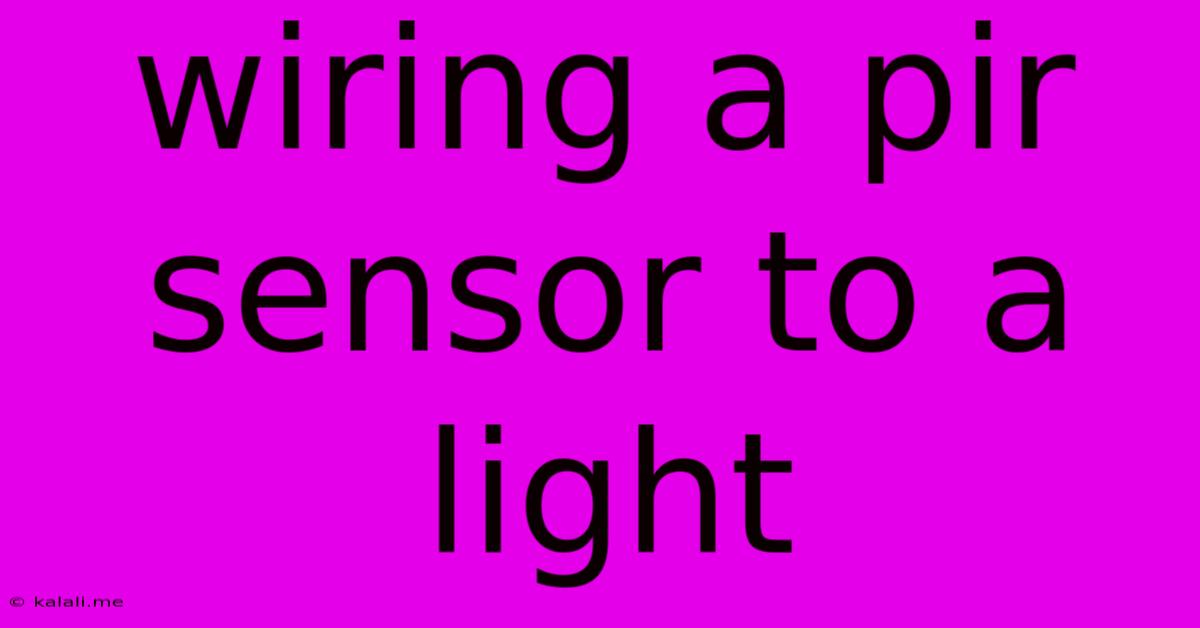Wiring A Pir Sensor To A Light
Kalali
May 22, 2025 · 3 min read

Table of Contents
Wiring a PIR Sensor to a Light: A Step-by-Step Guide
This guide provides a comprehensive walkthrough on how to wire a Passive Infrared (PIR) sensor to a light, enabling automatic light activation based on motion detection. This project is perfect for beginners looking to enhance their home automation skills, adding a touch of convenience and energy efficiency to their homes. This detailed explanation covers everything from choosing the right components to troubleshooting potential issues.
Choosing Your Components
Before you begin, you'll need the following components:
- PIR Motion Sensor Module: This is the heart of the project, detecting motion and triggering the light. Look for modules with adjustable sensitivity and detection range.
- Light Source: This could be a simple LED bulb, a string of LEDs, or even a larger light fixture. Ensure you choose a light that's compatible with your power supply.
- Power Supply: Select a power supply that can handle the current draw of both the PIR sensor and the light. A 5V DC power supply is commonly used for many PIR sensors and small LEDs.
- Connecting Wires: Use appropriately sized wires for your power supply and light. Solid core wire is easier to work with for beginners.
- Breadboard (Optional but Recommended): A breadboard makes prototyping and experimentation much easier, allowing for quick changes and connections without soldering.
- Jumper Wires (Optional but Recommended): If using a breadboard, jumper wires will make connecting the components much simpler.
Understanding the PIR Sensor
The PIR sensor works by detecting infrared radiation emitted by moving objects. When motion is detected, the sensor outputs a HIGH signal (typically 5V), which we'll use to activate the light. It usually has three pins:
- VCC (+): Power supply positive.
- GND (-): Ground.
- OUT (Signal): Output signal; HIGH when motion is detected, LOW otherwise.
Wiring Diagram
The wiring diagram below illustrates the basic connection for a PIR sensor triggering an LED:
+5V
|
|
+-----------------+ +---------+ +--------+
| PIR Motion |------>| |------>| LED |------> Ground
| Sensor Module | | Light | | (+) |
+-----------------+ | Source | +--------+
|
|
Ground
Detailed Explanation:
- Power Supply: Connect the positive (+) terminal of your power supply to the VCC pin of the PIR sensor.
- Ground: Connect the negative (-) terminal of your power supply to the GND pin of the PIR sensor and the negative (-) terminal of your light.
- Signal: Connect the OUT pin of the PIR sensor to the positive (+) terminal of your light source. This will activate the light when motion is detected.
Important Considerations:
- Current Limiting Resistor: If your light source requires more current than the PIR sensor can directly supply, you'll need to include a current limiting resistor in series with the light to prevent damage. The required resistor value will depend on the light's specifications.
- Light Type: The wiring might slightly vary depending on the type of light you are using. Always check the specifications of your light source before connecting it.
Testing Your Circuit
Once the wiring is complete, carefully connect the power supply. The light should remain OFF initially. When motion is detected within the PIR sensor's range, the light should turn ON. It will remain ON for a short period (typically adjustable on the PIR sensor module) before turning OFF automatically, even if motion is still present.
Troubleshooting
- Light Doesn't Turn On: Double-check all your connections, ensuring everything is securely wired. Verify the power supply is working correctly.
- Light Stays On Continuously: The PIR sensor might be faulty, or there might be a problem with its power supply.
- Intermittent Operation: The PIR sensor's sensitivity might need adjusting or it may be obstructed.
This guide provides a fundamental understanding of how to wire a PIR sensor to a light. While this is a basic setup, you can expand upon this project to create more complex systems involving multiple sensors and lights, potentially integrated with microcontrollers for enhanced control and functionality. Remember to always prioritize safety when working with electrical components.
Latest Posts
Latest Posts
-
Pokemon Firered What Level Does Magikarp Evolve
May 22, 2025
-
Can You Use Xbox One Controller On Xbox 360
May 22, 2025
-
How Long Can A Refrigerator Stay Cold Without Power
May 22, 2025
-
Symbols For Elements Earth Air Fire Water
May 22, 2025
-
Why Do I Get Electric Shocks
May 22, 2025
Related Post
Thank you for visiting our website which covers about Wiring A Pir Sensor To A Light . We hope the information provided has been useful to you. Feel free to contact us if you have any questions or need further assistance. See you next time and don't miss to bookmark.